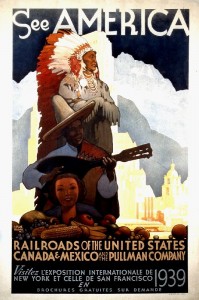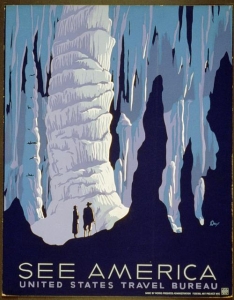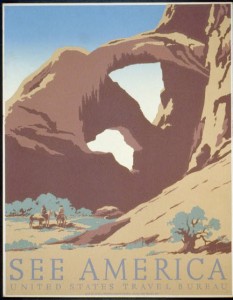
Leslie Darrell Ragan (1897-1972) | See America: Railroads of the United States, Canada, and Mexico and the Pullman Company, 1939 | Color lithograph | Florida International University, The Wolfsonian, TD1989.240.1
In the 1930s, despite the Depression, there was a boom in western states travel in the United States. There were a number of factors that helped to influence this increase: federally subsidized highway and road construction; the low cost of vacationing in the country’s national parks; and the United States “See America” campaign that was aided by the United States Travel Bureau’s Federal Art Project which commissioned artist-created posters to promote domestic travel.*
The Federal Art Project (FAP) posters were displayed in schools, community centers, and in subways, and were a significant aspect of 1930s American visual culture. The flatness of their design aesthetic, the application of broad planes of color, and the use of unadorned typography, linked these posters to the art deco style of the time. In addition to urging continental travel, FAP’s posters served to create jobs for artists, designers, and print shop personnel.
There were seven See America official travel posters commissioned by the United States Travel Bureau, a division of the Department of the Interior. These posters typically promoted visiting America’s natural wonders and the country’s national parks like Arches National Park in Utah featuring weathered natural sandstone arches, and the Carlsbad Caverns in New Mexico filled with magnificent stalactites and stalagmites. (see below)
Alexander Dux (20th c) Frank S. Nicholson (early 20th c) See America, c. 1936-39 See America, c. 1936-39 Silkscreen poster Silkscreen poster WPA, Federal Art Project WPA, Federal Art Project Collection of the Library of Congress Collection of the Library of Congress
The travel poster seen at the head of this essay was not part of the government’s travel promotional campaign. Instead it was probably created for the Pullman Palace Car Company out of Chicago and designed by Leslie Darell Ragan. Ragan was an illustrator from Iowa who had trained in Des Moines at the Cumming School of Art and then at the School of the Art Institute of Chicago. In the 1920s and 30s Ragan made his name designing posters that depicted trains moving though the landscape or iconic views of skyscrapers in their cities.
The focus of Ragan’s 1939 See America poster was the two fairs held on opposite coasts of the U. S. in 1939: the New York World’s Fair and the Golden Gate International Exposition in San Francisco. To emphasize the exotic peoples and cultures available for viewing at the San Francisco fair, in the foreground of the poster are depictions of a Native American chief wearing a massive feather head-dress, a Mexican American in his sombrero and serape playing a mandolin, and a beautiful Asian American with an abundance of fruits and vegetable displayed in front of her. Behind these three figures, a snow-covered mountain, a skyscraper (that looks like New York’s Rockefeller tower), a mission church, industrial smokestacks, and a streamlined locomotive may be seen. In the article cited above, Cory Pillen suggests that this juxtaposition creates an equivalency between the racially stereotypical figures representing different cultures within the western American experience and the iconic places and buildings that represent various American places. It is as though the people are on display at the fairs just as the places themselves are on display. Indeed, since the 1893 World’s Columbian Exposition in Chicago, American world’s fairs were as focused on the cultural ethnography of peoples as they were on the substantive developments in technology, architecture, and manufacturing. While this cultural ethnography was meant to be a scientific study of other peoples and their cultures, too often when focused on in the context of a world’s fair, the enclaves of people and the views of their homes and lives became an exemplar of the other or described as of primitive cultures, making these displays a contrast of ‘us versus them.’
* For an informative article on this subject see, Cory Pillen, “See America: WPA Posters and the Mapping of a New Deal Democracy” in The Journal of American Culture, 31:1 (2008): 49-65. There was also an earlier 20th century American travel slogan “See America First” that promoted travel within the United States initiated in 1905.
June 14, 2012
By Joyce K. Schiller, Curator, Rockwell Center for American Visual Studies, Norman Rockwell Museum








